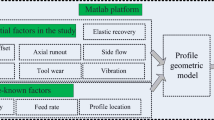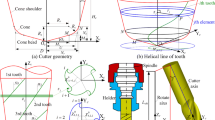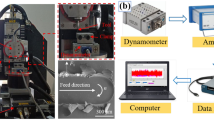Abstract
The effects of chip load, tool wear, and tool eccentricity on milling force are similar; in order to distinguish them from each other, the spectral characteristics of milling force for four flute end mills was studied. With simplified milling force model, the calculation expression of instantaneous milling force under tool eccentricity was derived based on the 2D geometry of tool cutting into workpiece. Using simulation methods, the amplitude spectra of milling forces under neither wear nor eccentricity, only eccentricity, both wear and eccentricity, and the every phase spectrum of force caused only by wear of one tooth were analyzed. The analysis results showed that the basic and third harmonic amplitudes of spindle frequency were linear only with eccentric distance, the fourth harmonic amplitude was linear only with feed, the second harmonic component was in relationship only with tool wear, and harmonics with same frequency caused by wear of different teeth were in phase or out of phase. Then corresponding milling experiments were done, the relations between experimental harmonic amplitudes of force and milling parameters were analyzed, and were found being in good agreement with above simulation results. These indicate that amplitudes of these harmonics could be taken as indices in recognizing eccentricity, wear, and chip load, respectively, and their variations contain in-process information of tool wear. This study proposes a new idea of identifying tool eccentricity and wear with force itself.
Similar content being viewed by others
References
Zhang S, Li JF, Sun J, Jiang F (2010) Tool wear and cutting forces variation in high-speed end-milling Ti-6Al-4 V alloy. Int J Adv Manuf Technol 46:69–78
Chao SS, Komvopoulos K (1998) Cutting force variation due to wear of multi-layer ceramic coated tools. J Tribol 120:75–81
Bayoumi AE, Barnal S, Hutton DV (1993) Prediction of flank wear and engagements from force measurements in end milling operations. Wear 170:255–266
Li HZ, Zeng H, Chen XQ (2006) An experimental study of tool wear and cutting force variation in the end milling of Inconel 718 with coated carbide inserts. J Mater Process Technol 180:296–304
Elbestawi MA, Papazafiriou TA, Du RX (1991) In process monitoring of tool wear in milling using cutting force signature. Int J Mach Tools Manuf 31:55–73
Sarhan A, Sayed R, Nassr AA, El-Zahry RM (2001) Interrelationships between cutting force variation and tool wear in end-milling. J Mater Process Technol 109:229–235
Jacob C, Joseph C (2005) An artificial neural networks-based in-process tool wear prediction system in milling operations. Int J Adv Manuf Technol 25:427–434
Ko TJ, Cho DW (1996) Adaptive modeling of the milling process and application of a neural network for tool wear monitoring. Int J Adv Manuf Technol 12:5–13
Susanto V, Chen JC (2003) Fuzzy logic based in-process tool-wear monitoring system in face milling operations. Int J Adv Manuf Technol 3:186–192
Girardin F, Remond D, Rigal JF (2010) A new method for detecting tool wear and breakage in milling. Int J Mater Form 3:463–466
Andersson C, Andersson M, Stahl JE (2011) Experimental studies of cutting force variation in face milling. Int J Mach Tools Manuf 51:67–76
Wan M, Zhang WH (2006) Calculations of chip thickness and cutting forces in flexible end milling. Int J Adv Manuf Technol 29:637–647
Wan M, Zhang WH, Qin GH, Tan G (2007) Efficient calibration of instantaneous cutting force coefficients and runout parameters for general end mills. Mach Tools Manuf 47:1767–1776
Wan M, Zhang WH, Tan G, Qin GH (2007) New cutting force modeling approach for flat end mill. Chin J Aeronaut 20:282–288
Sutherland JW, Devor RE (1986) Improved method for cutting force and surface error prediction in flexible end milling systems. J Eng Ind 108:267–279
Li HZ, Li XP (2005) A numerical study of the effects of cutter runout on milling process geometry based on true tooth trajectory. Int J Adv Manuf Technol 25:435–443
Liu C, Tan GY, Li GH, Liang JS, Li DR (2010) Feature analysis for milling force of three-edge end mills. Adv Mater Res 136:108–113
Liang SY, Wang JJJ (1994) Milling force convolution modeling for identification of cutter axis offset. Int J Mach Tools Manuf 34:1177–1190
Wang JJJ, Zheng CM (2003) Identification of cutter offset in end milling without a prior knowledge of cutting coefficients. Int J Mach Tools Manuf 43:687–697
Liu C, Li GH, Wu JQ, Tan GY (2011) Comparative study on force in milling T10 hardened steel with different machining parameters. Adv Mater Res 189–193:3079–3083
Lee KY, Kim HM, Park SS (2007) A run-out measuring method using modeling and simulation in four-fluted end milling. J Mater Process Technol 187–188:207–211
Yun WS, Cho DW (2000) An improved method for the determination of 3D cutting force coefficients and runout parameters in end milling. Int J Adv Manuf Technol 16:851–858
Liu XW, Cheng K, Webb D, Longstaff AP, Widiyarto MH (2004) Improved dynamic cutting force model in peripheral milling. Part II: experimental verification and prediction. Int J Adv Manuf Technol 24:794–805
Janez G, Martin K, Klaus W (2004) Mechanistic identification of specific force coefficients for a general end mill. Int J Mach Tools Manuf 44:401–414
Engin S, Altintas Y (2001) Mechanics and dynamics of general milling cutters—part I: helical end mills. Int J Mach Tools Manuf 42:2195–2212
Author information
Authors and Affiliations
Corresponding author
Rights and permissions
About this article
Cite this article
Liu, C., Wu, Jq., Li, Gh. et al. Frequency–spectrum characteristics of force in end milling with tool wear and eccentricity. Int J Adv Manuf Technol 67, 925–938 (2013). https://doi.org/10.1007/s00170-012-4537-x
Received:
Accepted:
Published:
Issue Date:
DOI: https://doi.org/10.1007/s00170-012-4537-x




